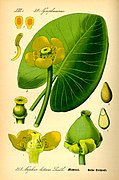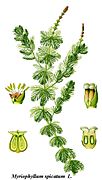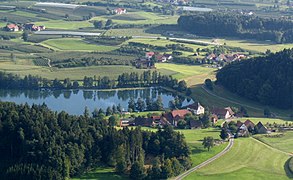Schleinsee (lake)
| Schleinsee | ||
|---|---|---|

|
||
| Schleinsee | ||
| Geographical location | Bodenseekreis , Baden-Wuerttemberg , Germany | |
| Tributaries | from meadow ditches and surrounding forests | |
| Drain | Betznauer Bach to Argen | |
| Places on the shore | Kressbronn districts Schleinsee and Nitzenweiler |
|
| Location close to the shore | Kressbronn on Lake Constance | |
| Data | ||
| Coordinates | 47 ° 36 '44 " N , 9 ° 38' 3" E | |
|
|
||
| Altitude above sea level | 474.3 m above sea level NHN | |
| surface | 14.1 ha | |
| volume | 966,000 m³ | |
| Maximum depth | 12.1 m | |
| Middle deep | 6.19 m | |
| Catchment area | 48 ha | |
|
particularities |
||
The Schleinsee is a still water in the area of the Baden-Württemberg community Kressbronn on Lake Constance in the Lake Constance district in Germany.
location and size
The lake is located around four kilometers northeast of the center of Kressbronn below the Schleinsee district of the same name in a nature reserve ( FFH area ) at an altitude of 474.3 m above sea level. NHN and is privately owned.
The size of the tub-shaped lake basin is 14.1 hectares , the length about 700 meters, the width 250 meters. The maximum depth of the lake is 12.1 meters. The bank zones in the west and east are flat and overgrown with plants typical of silting zones , in the north and south they are partly steeply sloping. The catchment area of the Schleinsee covers about 48 hectares; 20 percent of this is forest and 70 percent is used for agriculture. The shore length is around 1700 meters.
Emergence
Like the nearby Muttelsee , Wielandsee and Degersee , the Schleinsee emerged as a meltwater lake at the end of the last ice age around 15,000 years ago. The two above-ground tributaries are insignificant; the Schleinsee, however, is fed by several underground spring tributaries. The theoretically determined water renewal time takes about two years .
ecology
During the winter months, the Schleinsee is often covered with ice. In spring, after the ice break, the surface water of the lake warms up relatively quickly, so that water temperatures of 20 degrees are often measured, while the water temperature of Lake Constance has not even reached 10 degrees. The deep water rarely gets seven degrees warm. This means that the Schleinsee water remains separated into an upper warm water and a lower cold water layer from a depth of five meters until autumn. The water layers do not mix in the summer months because the lake is protected from the wind on almost all sides by wooded drumlin hills . Only when the water temperatures and thus the densities equalize again in the course of autumn and early winter through cooling, the entire body of water starts moving, which completely mixes the lake.
The catchment area of the lake is unusually only three times as large as its water surface, which is why it is relatively little susceptible to being polluted by pollutants from the surrounding area. From the 1930s, however, more and more untreated wastewater was discharged from a locality and the entry of fertilizers from the area also increased. The phosphorus concentration therefore rose to a very critical value by 1990.
| year | 1935 | 1941 | 1979 | 1986 | 1987 | 1990 | 1994 | 1995 | 1999 | 2007 | 2011 | 2016 |
| anorg. Total nitrogen (mg / l) | 0.59 | 4.08 | 0.53 | 0.71 | 0.62 | 0.28 | ||||||
| Total PO 4 - phosphorus (µg / l) | 24 | <30 | 78 | 122 | > 150 | 50 | 55 | 31 | 55 | 81 | 38 | |
| Chlorophyll a (µg / l) | 29 | 16 | 12 | 20th | 28 | 17th | ||||||
| Chlorophyll peak a (µg / l) | 23 | 45 | 91 | 44 | ||||||||
| Oxygen- free layer | 6th | 4-5 | 3 | |||||||||
| Viewing depth (m) | 1.8 | 1.0 | 1.7 | 2.4 | 2.3 | 1.7 | 1.9 | 2.2 |
The planned extensification measures were implemented with the help of the action program for the rehabilitation of Upper Swabian lakes , and the Bodenseekreis provided funding. By 1993 the lake again achieved more favorable values for the size of the oxygen-free layer than in 1985 and for the phosphorus concentration than in 1979.
flora
The white water lily ( Nymphaea alba ), a typical example of floating leaf plants, and the yellow pond rose ( Nuphar lutea ) grow on the western shore of the lake . As a habitat, the plants protected in Germany prefer standing or sluggishly flowing water with a humus silty soil. Also the milfoil ( Myriophyllum spicatum ) - it grows quite often in unpolluted eutrophic , rather calcareous, stagnant water with silty subsoil in diving leaf communities - and the rough horn leaf ( Ceratophyllum demersum ) can be found in the lake. The latter usually grows over humus mud soils in water depths of half a meter to ten meters. Furthermore, live blue , green and diatoms in the lake.
fauna
Until 1994 eel , perch , pike , carp , roach , rudd , tench , bleak , catfish and pikeperch were found in the lake. A fishing club stocked it with carp until 1998, and since 1999 the lake has been managed with a low population of pike.
Others
The first stage of the Anniversary Trail Bodenseekreis leads from the Kressbronn train station via Nitzenweiler and the small hamlet of Schleinsee - here you can visit the Baroque Assumption Chapel donated by Johann Melchior Sauter - up to the lookout point above the lake. The view extends over the Schleinsee, framed by countless flowering fruit trees in spring, and across Lake Constance to the 2,502 meter high Säntis in the Appenzellerland .
literature
- Hans Güde: Lake research at Schleinsee . In: Kressbronner Jahrbuch 1987/1988 . Kressbronn, S. 83-87 .
Web links
Individual evidence
- ↑ Coordination Center Lakes program PRO REGIO OBERSCHWABEN GmbH, Ravensburg, and Regierungspräsidium Tübingen / environmental, Dienstsitz Ravensburg








